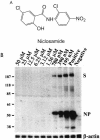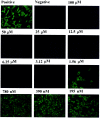Inhibition of severe acute respiratory syndrome coronavirus replication by niclosamide
- PMID: 15215127
- PMCID: PMC434198
- DOI: 10.1128/AAC.48.7.2693-2696.2004
Inhibition of severe acute respiratory syndrome coronavirus replication by niclosamide
Abstract
Antiviral agents are urgently needed to fight severe acute respiratory syndrome (SARS). We showed that niclosamide, an existing antihelminthic drug, was able to inhibit replication of a newly discovered coronavirus, SARS-CoV; viral antigen synthesis was totally abolished at a niclosamide concentration of 1.56 microM, as revealed by immunoblot analysis. Thus, niclosamide represents a promising drug candidate for the effective treatment of SARS-CoV infection.
Figures



Similar articles
-
Antiviral activity of nucleoside analogues against SARS-coronavirus (SARS-coV).Antivir Chem Chemother. 2006;17(5):285-9. doi: 10.1177/095632020601700506. Antivir Chem Chemother. 2006. PMID: 17176633
-
Inhibitory effect of mizoribine and ribavirin on the replication of severe acute respiratory syndrome (SARS)-associated coronavirus.Antiviral Res. 2005 Jun;66(2-3):159-63. doi: 10.1016/j.antiviral.2005.01.003. Epub 2005 Feb 19. Antiviral Res. 2005. PMID: 15911031 Free PMC article.
-
Helicases as antiviral drug targets.Hong Kong Med J. 2008 Aug;14 Suppl 4:36-8. Hong Kong Med J. 2008. PMID: 18708673
-
Synthesis of novel test compounds for antiviral chemotherapy of severe acute respiratory syndrome (SARS).Curr Med Chem. 2005;12(18):2095-162. doi: 10.2174/0929867054637644. Curr Med Chem. 2005. PMID: 16101496 Review.
-
[Present state of in vitro and in vivo studies on efficacy of medical nonspecific protective agents with respect to genotype IV coronavirus causing severe acute respiratory syndrome].Antibiot Khimioter. 2011;56(9-10):41-6. Antibiot Khimioter. 2011. PMID: 22586904 Review. Russian.
Cited by
-
Development of Targeted Drug Delivery System for the Treatment of SARS-CoV-2 Using Aptamer-Conjugated Gold Nanoparticles.Pharmaceutics. 2024 Sep 30;16(10):1288. doi: 10.3390/pharmaceutics16101288. Pharmaceutics. 2024. PMID: 39458617 Free PMC article.
-
Revisiting Niclosamide Formulation Approaches - a Pathway Toward Drug Repositioning.Drug Des Devel Ther. 2024 Sep 17;18:4153-4182. doi: 10.2147/DDDT.S473178. eCollection 2024. Drug Des Devel Ther. 2024. PMID: 39308694 Free PMC article. Review.
-
In vitro synergistic antiviral activity of repurposed drugs against enterovirus 71.Arch Virol. 2024 Jul 30;169(8):169. doi: 10.1007/s00705-024-06097-1. Arch Virol. 2024. PMID: 39078431
-
Dehydration of Niclosamide Monohydrate Polymorphs: Different Mechanistic Pathways to the Same Product.Cryst Growth Des. 2023 Jun 2;23(7):5102-5111. doi: 10.1021/acs.cgd.3c00322. eCollection 2023 Jul 5. Cryst Growth Des. 2023. PMID: 38510268 Free PMC article.
-
On the origins of SARS-CoV-2 main protease inhibitors.RSC Med Chem. 2023 Oct 13;15(1):81-118. doi: 10.1039/d3md00493g. eCollection 2024 Jan 25. RSC Med Chem. 2023. PMID: 38283212 Free PMC article. Review.
References
-
- Centers for Disease Control and Prevention. 2003. Update: severe acute respiratory syndrome—United States, June 18, 2003. Morb. Mortal. Wkly. Rep. 52:570. - PubMed
-
- Cory, A. H., T. C. Owen, J. A. Barltrop, and J. G. Cory. 1991. Use of an aqueous soluble tetrazolium/formazan assay for cell growth assays in culture. Cancer Commun. 3:207-212. - PubMed
-
- Katz, M. 1977. Anthelmintics. Drugs 13:124-136. - PubMed
-
- Ksiazek, T. G., D. Erdman, C. S. Goldsmith, S. R. Zaki, T. Peret, S. Emery, S. Tong, C. Urbani, J. A. Comer, W. Lim, P. E. Rollin, S. F. Dowell, A. E. Ling, C. D. Humphrey, W. J. Shieh, J. Guarner, C. D. Paddock, P. Rota, B. Fields, J. DeRisi, J. Y. Yang, N. Cox, J. M. Hughes, J. W. LeDuc, W. J. Bellini, and L. J. Anderson. 2003. A novel coronavirus associated with severe acute respiratory syndrome. N. Engl. J. Med. 348:1953-1966. - PubMed
-
- Lee, N., D. Hui, A. Wu, P. Chan, P. Cameron, G. M. Joynt, A. Ahuja, M. Y. Yung, C. B. Leung, K. F. To, S. F. Lui, C. C. Szeto, S. Chung, and J. J. Sung. 2003. A major outbreak of severe acute respiratory syndrome in Hong Kong. N. Engl. J. Med. 348:1986-1994. - PubMed
Publication types
MeSH terms
Substances
LinkOut - more resources
Full Text Sources
Other Literature Sources
Miscellaneous

